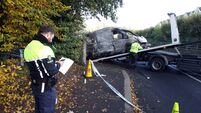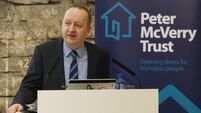Rory Hearne: Homelessness in Ireland now exceeds pre-pandemic levels

The number of homeless families increased by 47%, from 925 families and 2,193 children in April 2021 to 1,366 families and 3,028 children in May 2022. Picture: Yui Mok/PA
The lifting of Covid-related eviction bans and rent freezes, combined with the explosion in the costs of living and lack of truly affordable housing has contributed to house and rent price rises, a surge in evictions, rent, and mortgage arrears, and homelessness across Europe.
But Ireland is one of the worst affected.
Homelessness in Ireland has returned to, and exceeded, pre-pandemic levels.
Ireland also has the second-highest rate of households in arrears on their rent or mortgage in the EU.
Almost 20% of poorer households in Ireland are in arrears, over double the EU average.
These are the stark findings of the European Federation of Organisations Working with the Homeless (FEANTSA) in its latest report, .
Given the decline in mortgage arrears, this points to a major increase in households with rent arrears in Ireland.
It's unsurprising when rents have increased by 11% in the last year, and 64% since 2010 in Ireland — even higher in Dublin, Cork, and other cities. In contrast, there was just a 14% average increase in rent across the EU since 2010.

Figures from the Residential Tenancies Board show rent arrears cases falling from 401 disputes in quarter one of 2019, to 270 in Q2 2020 (the period of eviction bans), but then rising to a high of 531 in Q2 of this year — a 32% increase in rent arrears on 2020.
Housing charity Threshold has experienced an increase in support sought by tenants in rent arrears, due to reductions in earnings during Covid, and increasing rent unaffordability.
As house prices, rent, and utilities — particularly heating and lighting — has increased across the EU, the gap in household incomes has widened, leading to higher indebtedness and arrears for some households, especially lower income ones.
The FEANTSA report also highlights worrying levels of substandard housing conditions in Ireland — 16% of all households in Ireland, and 28.6% of poor households, are living in damp housing.
This is significantly higher than the EU average.
With increased children and families living in the private rental sector, they are exposed to this.
The Mica crisis, emergency accommodation, and some substandard social housing add to this.
Almost one in three children living in poor households in Ireland are growing up in such substandard housing conditions. That is significantly higher than the EU average of 22%, and over three times the rate in Austria of 9%.
Homelessness is the most extreme form of social exclusion and we have a moral imperative to eliminate it if we are serious about building a fair and inclusive society.
Housing and assisting the homeless is a core principal in the European Pillar of Social Rights. Yet it is growing across the EU.
FEANTSA identifies rising evictions as a key reason. Being evicted from your home, your place of sanctuary and haven, especially for children and families, is a form of institutional violence with dramatic social and economic consequences.
Research in Sweden showed a correlation between evictions and suicides.
People who have lost the legal right to their home and whose landlord has enforced an eviction order were four times more likely to die by suicide.
Sadly, the swift and effective action by Governments and NGOs working with homeless people during the Covid pandemic has not been continued.
The eviction bans (eviction notices fell by 83% in 2020), and rent freezes, put in place from March 2020 to April 2021, meant a dramatic fall in families being made homeless.
In the three months after the eviction ban was introduced in March 2020, just 131 notices to quit were issued.
In the first three months of this year, 10 times that number were issued, the highest since data collection started in 2019.
There have been 3,818 eviction notices issued since the Covid ban on evictions was lifted last April.
The eviction ban and rent freeze were removed in April 2021, tourism returned, landlords evicted tenants in ever greater numbers, rents rose, social and affordable housing provision remained inadequate, and we are now back in pre-pandemic levels of the homelessness crisis.
The number of homeless families increased by 47%, from 925 families and 2,193 children in April 2021 to 1,366 families and 3,028 children in May 2022.

We have the highest number of adults homeless in Ireland (7,297) since the current crisis emerged in 2014.
FEANTSA highlight the positive commitment of all EU Member States (including Ireland) to eradicate homelessness by 2030.
But they are clear the cost-of-living crisis will make it increasingly difficult for many households to cover housing costs so “the risk of homelessness, especially for vulnerable people can be expected to increase”.
They call on governments to introduce additional measures to prevent this, such as financial support for those in rent arrears, restructuring of debts for vulnerable families and no evictions into homelessness.
Examples of countries taking positive steps are the Netherlands which aims to end the use of emergency shelters as a response to homelessness, as it shifts to prevention, rapid rehousing, and fast-tracking construction of affordable housing.
The Simon Community's Homeless Prevention Bill passed second stage in the Dáil in December last year.
The Government committed to progress it. While notice periods have been extended recently, the key homeless prevention parts of the Bill remain to be implemented.
In particular, providing local authorities with the power to intervene, both in advance of, and at a crisis point of eviction, to prevent homelessness.
Government needs to pass legislation to keep tenants in their homes.
Two thirds of evictions are because the landlord is selling.
The sale of property as a grounds for eviction of a tenant should therefore be removed. Landlords could still sell, but tenants would remain in place, reducing homelessness.
In a welcome move, local authorities can purchase such properties with tenants are in situ. However, leaving landlords with the ability to evict a tenant when selling their property, means an absence of real security for tenants, and homelessness is likely to continue to increase.












